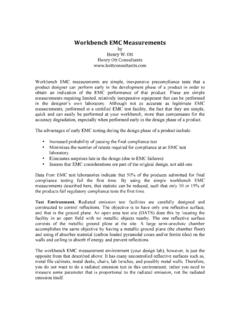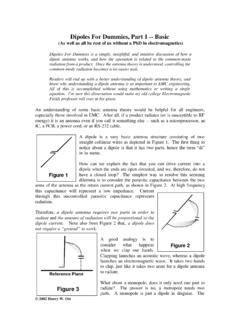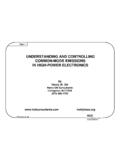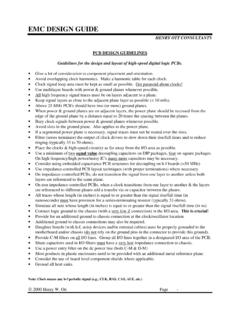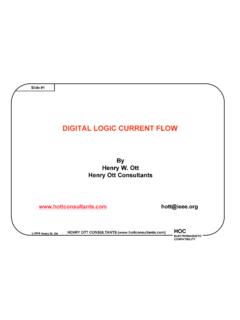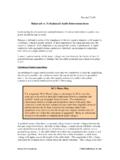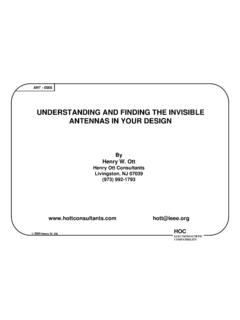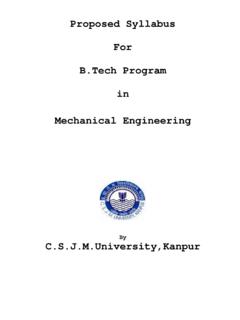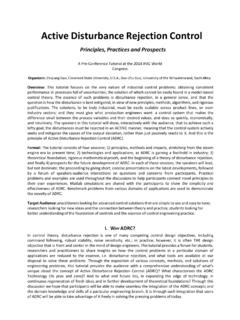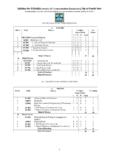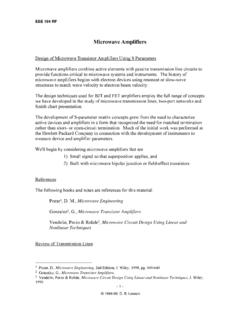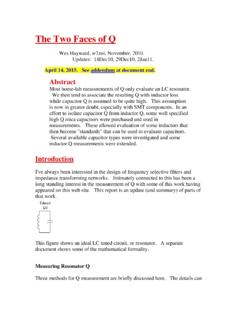Transcription of Part 3 -- Advanced
1 2002 Henry W. OttDipoles For Dummies (As well as all he rest of us without a PhD in electromagnetics) part 3 -- AdvancedIf you followed the discussion so far, you are now ready to move to the Advanced we will determine the impedance of a dipole antenna. The impedance is importantbecause it affects the ability to couple energy into the antenna structure. Interestingly,many antenna books do not bother to calculate to Figure 2 (in part 1), we can see that one of the elements of the antennaimpedance will be a capacitor. We also know that the wire arms of the antenna musthave inductance, and this inductance will be in series with the the antenna radiates, some energy will be lost and this lostenergy must be accounted for in our model. The onlycomponent that will dissipate power is a resistor; so let s addthat to our model in series with the inductor and , the equivalent circuit for a dipole antenna becomesa series R-L-C network as shown in Figure 13.
2 We call theresistor the radiation resistance since it represents the energythat is lost as 13 clearly shows that the dipole will behave as a series resonant R-L-C circuit. Atlow frequencies the dipole impedance will be capacitive, at high frequencies it will beinductive, and at resonance it will be impedance of a monopole is one half that of adipole. This can be seen by studying Figure 14. Theinductance and resistance will be one half that of thedipole and the capacitance will be twice that of the resonant frequency the input impedance tothe antenna will be large (> 1,000 ohms) due to theimpedance of the capacitor. Above the resonantfrequency the impedance will also be large (> 1,000ohms) due to the impedance of the inductor. Atresonance, however, the impedance will be low (<100ohms) since the inductive reactance will cancel the capacitive reactance, leaving just theradiation resistance.
3 The well-known value for the radiation resistance of a thin, half-wavelength dipole is 72 ohms, for a monopole it will be half of that or 36 will be difficult for the common-mode voltage (or any other voltage for that matter) todrive much current into the antenna when the input impedance is large. However, it willRCLF igure 13L/2L/2L/2R/2R/2R/22C2C2 CMonopoleDipoleFigure 14 2002 Henry W. Ottbe easy to push current into the antenna at resonance when the impedance is , dipole (monopole) resonance is important to us with respect to EMC. At theresonant frequency it is much easier to couple energy into the antenna and it willtherefore be a more efficient it turns out, the resonance frequency of a dipole is related to its length, Resonance willoccur when the antenna s length is approximately one half wavelength (one quarterwavelength for a monopole).
4 Additional higher frequency resonances will also occur atfrequencies that are odd numbered harmonics of the half-wavelength resonant frequency(odd numbered harmonics of the quarter-wavelength resonant frequency for a monopole).At these frequencies the radiation will be increased because of the low impedance of but not least, let s compare the performance of the dipole and monopole as example, let s say that I measure the field at a point in space d-meters from and at a45-degree angle to the axis of a dipole. How will this compare to the field measured at asimilar point away from a monopole of one half the length and carrying the same current?This is depicted in Figure answer this we can use the theory of images. The easiest way to understand thetheory of images is to consider something that we are all familiar with, a mirror.
5 Afterall, light is electromagnetic energy similar to what we have been discussing, except of adifferent you look into a mirror (a reflective surface) what do you see. You see yourself! If youmove three steps back from the mirror, what does your image do? It also moves threesteps back. Therefore, a mirror produces an image of you, and the image is located as farbehind the mirror as you are in front of the mirror. The same thing happens with amonopole above a reference plane (a reflective surface). A reference plane produces animage of the monopole as far below the plane as the antenna is above the = X volts/meterE = ? volts/meterDipoleMonopoleFigure 15 2002 Henry W. OttSaying it slightly differently, the field produced at any point in space in the upperhemisphere, by a conductor perpendicular to a reflective plane is equivalent to the fieldthat would be produced by the originally conductor plus a second identical conductorlocated an equal distance below the plane as the original conductor is above the plane, butwithout the plane present.
6 Figure 16 shows this , the answerto our original questionis that as long as welimit ourselves toconsidering the fieldsin the upperhemisphere (above thereference plane), themonopole and thedipole produce theexact same hope by now that you have a much better intuitive understanding of dipole andmonopole antennas, and why they are important to EMC engineering. Note also, that wehave done it all without using any mathematics or writing any s summarize what we have covered: A dipole antenna requires two parts. The magnitude of the radiation will be proportional to the dipole current. A dipole antenna does not require a ground to work. A monopole is just a dipole in disguise, and also requires two parts. The way to make a dipole antenna radiate is to have an RF potential between twopieces of metal. The way to prevent radiation is not to have a potential difference between the twohalves of the antenna.
7 The internal circuit reference (ground) of a product should be connected to thechassis as close to where external cables terminates as 16 2002 Henry W. Ott The polarization of an antenna represents the orientation of the electric fieldproduced by the antenna. The effective height of an antenna is defined as the ratio of the voltage inducedinto the antenna to the magnitude of the incident electric field. Adding metal (capacitance) to the end(s) of a dipole or monopole antenna willincrease their radiation efficiency A PCB should be mounted as close to a metal chassis as possible, and have itsground connected directly to the chassis. A plastic enclosure should include a metal reference plane. The equivalent circuit of a dipole (or monopole) is a series R-L-C circuit. At its resonant frequency, it is much easier to couple energy into an antenna and,therefore, it will be a more efficient radiator at its resonant frequency.
8 Antenna resonance will occur when each arm of the antenna is one-quarterwavelength long. Multiple resonances will occur that are odd numbered harmonics of the resonantfrequency. A monopole and dipole both radiate the same you would like to learn more about antennas, you might consider our new one-day Antenna Theory Simplified class. In it we do use mathematics and write , we use circuit theory (not field theory) to develop simple and accurate circuittheory models for the dipole and loop antennas, which provide the participants with anintuitive understanding of antenna operation. Comparing the models to know field theoryresults then validates the circuit theory models developed. Other antenna structures suchas the Yagi, Log Periodic, Biconical, and Bilog are also more information on the class look on the Henry Ott Consultants web site under In-Plant EMC Training and then click on One-Day EMC Seminars, or go directly Ott Consultants(973)
